Most die-hard baseball fans are well aware that Rawlings has been the official and exclusive supplier of baseballs for Major League Baseball for over a quarter-century. They may even know that each Rawlings Official Major League Baseball (ROMLB) is made in Costa Rica. But what most baseball enthusiasts might not know is the extreme scrutiny and the barrage of tests and inspections that every baseball must go through before they ever reach the pitcher’s mound of every MLB ballparks across the country and Canada.
Rawlings Sporting Goods began manufacturing baseballs in 1955 when Spalding bought out the company. And even though American League and National League balls were both made by Rawlings, American League balls were stamped with the Rawlings logo and National League balls were stamped with the Spalding logo. Because of an anti-trust investigation in 1968, Spalding was forced to sell the Rawlings portion of its company but entered into a contractual agreement with Rawlings to have them continue manufacturing National League baseballs with the Spalding logo on them.
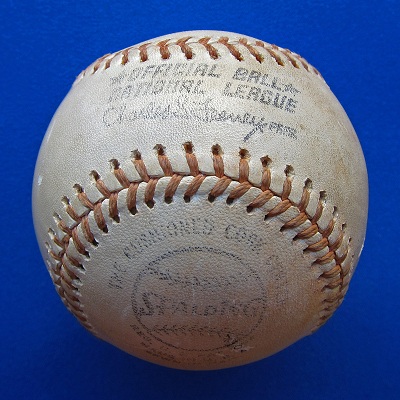
Even though this 1974 National League ball has a Spalding logo on it, it was manufactured by Rawlings.
In 1977 Spalding’s exclusive National League naming agreement expired and Rawlings began using their own trademark logo on both American League and National League baseballs. Although identical, each league’s ball had their own league logo with their respective president’s name stamped on them. The American League balls were in blue ink and the National League in black ink. Even though Rawlings has actually been making Major League baseballs for both leagues since 1955, it wasn’t until 1977 that Rawlings was recognized as the official and exclusive manufacturer for both leagues – hence that quarter-century thing instead of more than a half-century, which it has actually been.
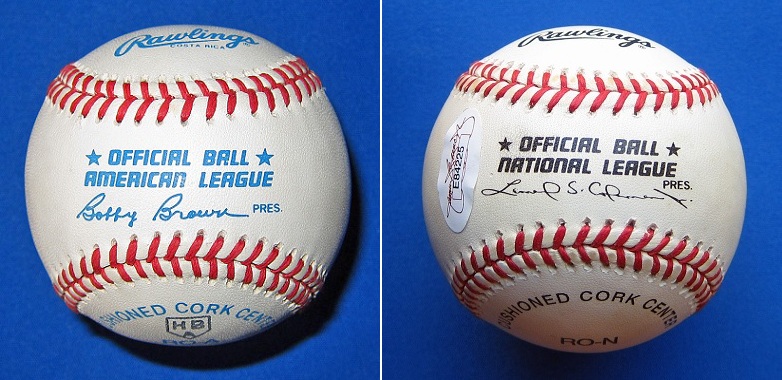
When the Spalding logo agreement expired in 1977, Rawlings began putting their logo on both American League and National League balls in blue ink and black ink respectively.
Up until 1987, all Rawlings baseballs were manufactured in Haiti, but sensing political instability in the small island country, Rawlings opened a second factory in the friendly Central America country of Costa Rica. This move proved to be a wise one for Rawlings, as increasing political tension forced Rawlings to shut down their Haiti factory in 1990 and allowed the Costa Rica factory to continue manufacturing baseballs without interruption.
In 2000, Major League Baseball did away with individual league presidents, thus giving full governing authority over both leagues to the commissioner of baseball. At this same time, the MLB also did away with league-specific baseballs (even though they were the exact same ball but with separate league markings) and went with a single identical logo for both leagues – thus the ROMLB was born.
Rawlings now produces 80,000 dozen ROMLBs annually at its Costa Rica plant – this not counting baseballs made exclusively for the World Series, the All-Star Game and other special events such as the World Baseball Classic, etc.
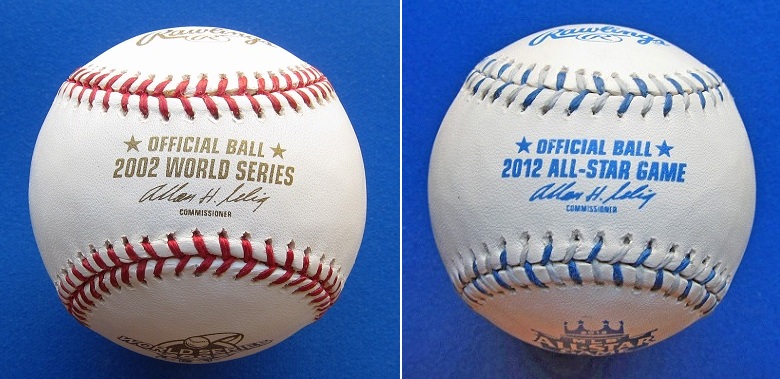
Rawlings makes event-specific balls for the World Series, the All-Star Game, (including the Home Run Derby), the World Baseball Classic and other special events.
Rawlings also makes all official Minor League baseballs, but do so at a factory located in China. Unlike the Major League balls made in Costa Rica, the Minor League balls include a stamp indicating that they were made in China. This is probably due to some type of trade agreement between China and the United States.
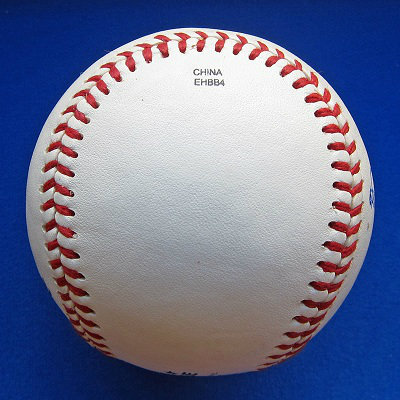
Rawlings Official Minor League Baseballs very closely resemble their Major League counterparts but are manufactured in China.
MLB’s strict specifications for the manufacturing of each ROMLB calls for a cork center (called a “pill”) that is wrapped in two thin rubber layers and weights exactly 7/8 oz. This pill is then machine-wound under consistent tension with 121 yards of four-ply blue-gray wool yarn, 45 yards of three-ply white wool yarn, 53 more yards of three-ply blue-gray wool yarn, and 150 yards of fine white poly-wool blend yarn. When finished, the yarn-covered ball (called a “center”) is coated with an adhesive and two separate pieces of elongated figure-8-shaped white cowhide covers are placed on it. Once the covers are applied to the center, they are double stitched together by hand using 88 inches of 10/5 red cotton thread. It takes approximately 10 minutes to hand sew the 108 stitches into each baseball, with the first and last stitches completely hidden. Once stitched, the ball is machine rolled for 15 seconds to assure that the newly sewed seams are flat and even. The balls are then stamped with the Rawlings trademark, the MLB logo, and the commissioner’s signature and allowed to dry for a week. When finished, each ROMLB must weigh between 5.0 and 5.25 oz and be within a tolerance of 2.86 to 2.94 inches in diameter and 9 to 9.25 inches in circumference.
Although ROMLBs are manufactured in Costa Rica, the cowhide for the covers actually comes from the United States and is closely inspected for 17 different defects such as stretch marks, tick bites, barbwire marks, etc. and is tested for tensile strength. It is then sent to the Tennessee Tanning Company in Tullahoma, TN where it is alum tanned (which gives it its bright white color) and then shipped to Costa Rica.
But wait… there’s more!
Completed balls are then inspected for weight and diameter to confirm that they meet the strict MLB specifications and several balls from each shipment are randomly selected and shot from an air cannon at 85 feet per second against a wall made of northern white ash (the same wood used to make baseball bats). Each tested ball must bounce back between 0.514 and 0.578 of its original speed to be suitable for MLB use. The balls are then shipped to the U.S. where they are again inspected by weight and diameter. ROMLBs that make the cut are then sent to each of the 30 MLB teams for game use and those that do not are sold on the retail market (for collectors and autograph seekers, etc.) or sold to MLB teams at a reduced price to be used for batting practice balls or for promotional purposes.
But wait… there’s still more!
Once an MLB team receives its shipment of ROMLBs, each ball is hand rubbed with a special mud that comes from a remote (and secret) stretch of the Delaware River in New Jersey. It is this mud that gives each game-used ROMLB its off-white and slightly darkened color – almost dirty looking (go figure).
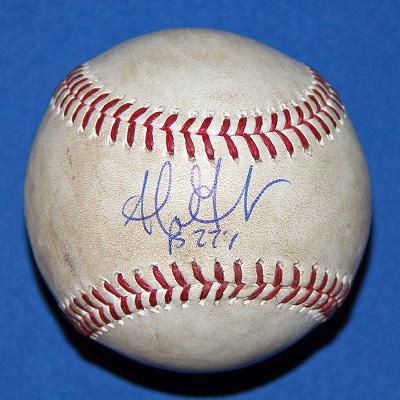
It’s pretty easy to spot a game used ball because of the Delaware River mud that has been rubbed onto it. Hey… who wrote on my Adrian Gonzalez home run ball?
Rubbing mud onto the balls removes the ball’s slick, shiny outer coating, allowing pitchers to have a better grip and more control. It also dulls the bright white sheen on them which, if not done, gives a distinct advantage to hitters. Hitters, on the other hand, will sometimes argue that a ball with too much mud is too dark and makes it difficult to see (and hit). This is why umpiring crews closely examine each and every mud-rubbed baseball (for consistency) in the umpire’s room prior to every MLB game.
* * * * * *
Ball Trivia
- Six to seven dozen baseballs are used in a typical Major League game.
- The average life of a baseball in the Majors is 6 pitches.
- The terms “live ball” and “dead ball” have been applied to baseballs for more than 100 years. In the early years of the game, the home team was expected to provide the game balls and a good hitting team would wind their baseballs tightly for a lively (live ball) effect, while a good defensive team would wind their baseballs looser for a softer (dead ball) effect.
- In 1857 the length of a game was set at nine innings and pitching was done “underarm” (underhand) from a distance of 45 feet and the batter was out if a fielder caught the ball on the first bounce.
- In 1978 Rawlings began manufacturing the commemorative ROMLB World Series game baseballs with distinctive trademarked logos. Rawlings continues to manufacture these event-specific baseballs for three years following the actual event.
- Since 1983 Rawlings has been manufacturing special commemorative ROMLBs for events such inaugural stadium openings, franchise or stadium anniversaries (such as this year’s Dodger Stadium 50th anniversary), and other milestone events such as Derek Jeter’s 2,000th hit, to name just a few.
PLAY BALL!
(Article re-posted from October 17, 2012)




 October 17th, 2012 at 12:05 pm
October 17th, 2012 at 12:05 pm  by Ron Cervenka
by Ron Cervenka 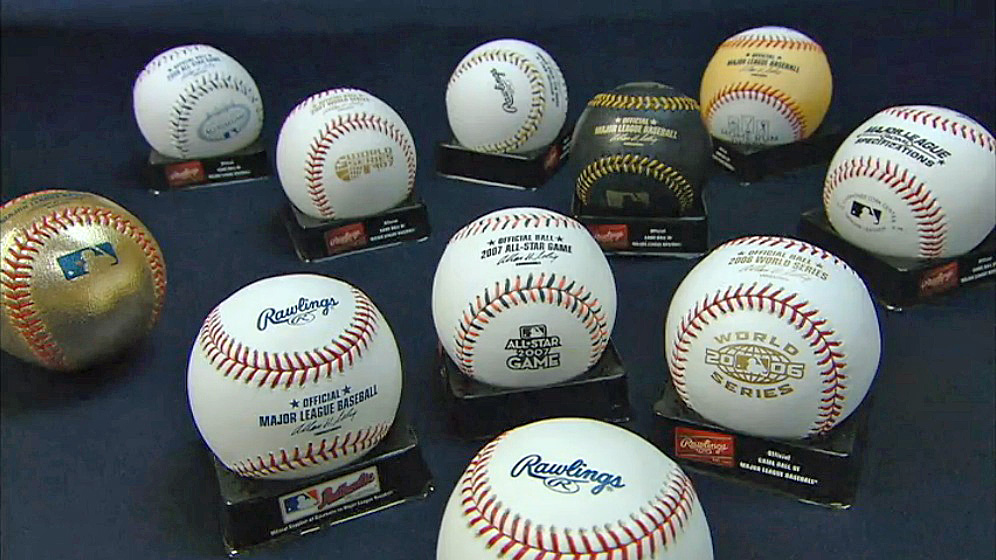
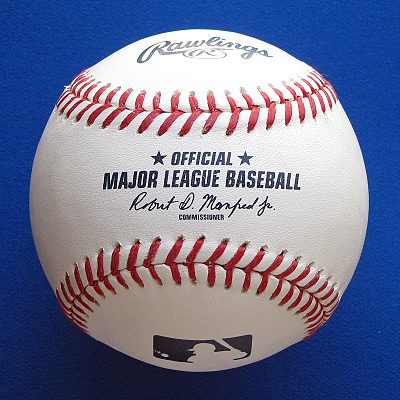

 Posted in
Posted in 

This article was so interesting I kept coming back to it (4 times) after work interruptions. Now I wonder how they can sell them for $12-13 with all that work. Wonder what it would cost to manufacture in the US.
Huh! I knew that. That is, the balls were rubbed with mud.
Didn’t know much of the rest. That’s almost 1,000,000 baseballs stitched by hand.
Verrrrry interesting…but not stupid! Lots of good info, thanks Ron! Is there a required number of baseballs that the home team has to have available before each home game?
There probably is but I don’t know what that number is. Next time I see Mitch Pool I’ll ask him.
MLB provides 110 dozen to each team at no cost every year (a pittance) and most teams purchase an additional 2,500 to 3,500 dozen each year (at far below what you and I pay for them, of course).
I know that when I would go into the Dodgers clubhouse, there were always several dozen boxes in there – probably waiting to be muddied up.
You probably have close to 110 dozen at your place Ron!
110 X 12 = 1,320
Pretty close.
Went 80,000 x 12 – didn’t know if the special events would take more than 40,000 baseballs. Missed the 110 somehow.
No matter, a whole lot of stitching goin’ on.
I asked the Quakes Clubbie about the number of balls used once. He told me there are usually 6 dozen on hand, mudded, ready for use. It’s more in the majors, probably closer to or over 10 dozen. They give away for balls in the majors with there being almost no way to get one back if it’s fouled out of play. Oh, and the clubhouse attendants HATE when players give balls away since they are in charge of them. I say a few players get scalded in the dugout this year for doing it…but they would still do it anyway.
Also, if a team has a Major League pitcher rehabbing with them that team is responsible for providing the ROMLBs for that pitcher or pitchers to throw, even if they are on the road. Some lucky fans went home with Dodger Stadium 50th balls this year if they were at a Quakes game when Lilly or De la Rosa pitched.
Garrett – good info on Quakes. I can recall in little league there was almost nothing better than a new baseball. We only had something like twenty or so for the season, including practice.
The only thing better was the sweet aroma of a new glove. Didn’t get that very often either.
Enjoyed your article, one of my favorite topics. Just thought I’d clarify and provide some corrections: The AL balls actually carried the Reach brand logo, not Rawlings, until 1974. Then Spalding took over stamping for both league balls through 1976. The first Rawlings stamped balls weren’t put in play until 1977.
Size of the MLB baseball is 5 to 5 1/4 ounces, according to MLB rules. The circumference must be 9 inches to 9 1/4″.
Last correction, a big one for me, Special Event ball started in 1983, not 2001. You could even argue 1979 (Japan/MLB All-Star Series in 79 had a ball). There are so many awesome special event game balls, particularly from 92-2001. Check them all out here in our Museum: http://photos.bigleaguebaseballs.com/
Thanks for the clarifications, BigLeague. As I began my research, I quickly found a number of discrepancies in the material that I researched. I tried to use only references that had at least two forms of corroboration but in some cases there simply wasn’t any. Verification for accuracy was equally difficult. Aside from the errors that you mentioned, I think I got most of it right, however.
Don’t know how I missed my typo of 0.5 ounces instead of 5.0 and missed the additional 1/4 of an ounce in weight variance. I imagine that it would be nearly impossible for every ball to weigh exactly 5.0 ounces.
I am an absolute nut when it comes to ROMLBs, so I will definitely be spending time on your site.
Thanks again for dropping in and your corrections have been noted in the article. Please don’t be a stranger.
No problem at all. It was a really well written article and very well-researched, I can tell. I’ve covered this topic for 3 years and haven’t even found some of the info you did, or if I have I’ve forgotten to post it. Very impressive – wish I had written a similar article on our website with this much detail.
I’ve also found some of the same issues trying to find dependable information. There aren’t many official sources out there to use. If there are, they’re buried in a library somewhere or perhaps withone someone at SABR. So I speculate a lot and offer mostly opinions.
Even our Rawlings sources don’t know a lot about the history of the game ball, or their own history, because a lot of this must not have been recorded. There is no official guide to the commemoratives, which is one reasons I started our site.
Thanks again I enjoy the site and will a regular reader during the season!
I just stumbled across your article while searching around google for info about Rawlings MLB baseballs. First, nice job on the article. You have a lot of great information in here. The Discovery Channel’s show “How it’s Made” did an episode on Rawlings baseballs and here’s the link if you’re interested:
http://www.bigleaguebaseballs.com/main/baseballs-how-its-made/
Also, do you have any idea who makes the red thread that Rawlings uses to lace their balls. I sell wallets which are sewn like baseballs and have been trying to find their thread supplier for years, but without any success. You can see my wallets online at prostylesports.com. Thanks again for the information and help!
Thanks for the reply and kind words.
As I’m sure you discovered in your research, Rawlings is extremely protective of their baseball-making process, especially when it comes to information about the components used in the manufacturing of official major league baseballs – and understandably so. They do not want to run the risk of someone tampering with the materials.
I usually visit Costa Rica at least once a year to go sport fishing with friends and on my last visit I attempted to set up a visit to the Rawlings manufacturing plant but my calls were never returned. I will try again on my next visit.
Good luck with your wallet venture.
[…] Haiti to Costa Rica after the collapse of Haitian dictator Jean-Claude Duvalier’s regime. From 1988 to 1990, baseballs were produced in both countries before the Costa Rican facility took over completely. […]
Hello Ron…..who in the Rawlings camp (or elsewhere) might know something, anything!, about the five types (4 souvenir, 1 match) of Rawlings balls made for the 1984 Olympics in LA? Thx, Peter, VMOBS (99.9% of Rawlings balls imprinted “THE GAME BALL” and sold on eBay are souvenir/commemorative balls, not the true match (game used!!) ball)
Peter,
I wrote and ran this story back in 2012 and have done no further research into it, primarily because of the lack of cooperation from Rawlings. As such, I am unable to answer your question.
That being said, with all of the humidor stuff in the news over the last week about the baseball manufacturing process, I expect that we will be hearing and reading a lot more about it in the coming days and weeks.
Thanks for dropping in with us.
Ron
when were “Official League OPB-3 baseballs made?
Not sure when they were introduced, but they are still made today according to the Rawlings website:
https://www.rawlings.com/product/OLB3.html
HI everyone… I have a ball that is red/blue stitched with red blue ink…red being in center… I think it also appears to be in Latin… I think ?
I can’t even venture a guess on that one, but your Latin assumption is probably a good one. I found nothing as you described on the Rawlings website:
https://www.rawlings.com/balls/baseballs/
Great article, updates, facts, corrections, and comments with this topic. I have several older balls with autos and what-not and love the history of the ROMLB. Thanks a bunch.
Hello Ron,
I just purchased an older Rawlings baseball with a an inscribed note:
To: Marc
Marc E. Delorme (I have not been able to find out if he made it to the “Majors”?)
From: Dad
Spring Training
Winter Haven
for: $2:00 Canadian
Thanks for all the “info” on Rawlings Baseball history!
I made it to pony league in South Euclid Ohio! Left hander, 1st baseman
Cheers,
Alan Katowitz Photography
Awesome! I’m like a little kid whenever I’m around a signed baseball, no matter whose it is!
Couldn’t find any record on Marc E. Delorme making it to The Show.
Thanks for dropping in on us. Don’t be a stranger. You are among friends here.
[…] https://thinkbluela.com/2012/10/rawlings-puts-the-ball-in-baseball/ […]